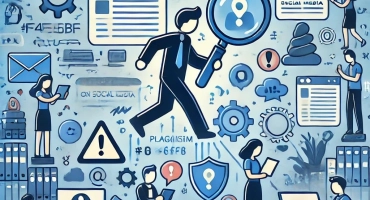Plagiarism in Business: Why It Matters and How to Avoid
Table of contents
This guide aims to take you through some typical cases of plagiarism in business and provide tips on how to avoid them.
Generally, plagiarism in business is a critical issue, as it undermines the integrity of the work and can lead to legal and reputational consequences. In the corporate world, originality and creativity are highly valued, and using someone else’s work without permission or proper attribution can harm the company’s reputation and credibility.
Sadly, several professionals are not overly concerned about the consequences of plagiarism in business. So, they keep repeating it in their operations regardless of the outcome. Unfortunately, the act can lead to potential legal action and loss of trust from customers and stakeholders.
So, businesses must have clear policies to detect and prevent plagiarism. They also need to educate their employees on the importance of ethical practices in the workplace. Using a reliable plagiarism detector is a crucial step in maintaining this integrity.
What is plagiarism in business?
There are diverse definitions of plagiarism in business. But generally, it refers to using another person’s ideas, words, or work, attributing it to them, or obtaining their permission, before presenting it as your original effort.
This can occur in various contexts in business, such as social media plagiarism, copying content from a competitor’s website, presenting someone else’s research as one’s own, or using another company’s branding or logo design without permission.
Plagiarism in business is unethical and can bring legal consequences. It can damage the reputation of a firm and cause the customers and stakeholders to lose their trust. As such, businesses must create policies to guide all employees and stakeholders to pursue ethical practices in their work.
Types of plagiarism in business
At the corporate level, plagiarism comes in different forms, including:
- Copying and pasting
This is one of the most common type, which nearly every individual in the business space understands. Copying and pasting are commonly referred to as direct plagiarism. It involves taking texts from another source, such as a website or a document, without altering the information and pasting it into a present task.
- Paraphrasing without citation
Restating another person’s ideas or words in a different way constitutes paraphrasing. This can still be considered plagiarism if there is no proper credit to the main source. For example, plagiarism in politics is also found, where candidates increase their chances of winning by finding plagiarized data in the form of a speech or political education.
- Accidental plagiarism
It occurs when someone unintentionally uses another person’s ideas, words, or work without proper attribution or citation. It can happen for various reasons, including a lack of knowledge about rules, careless note-taking, or failure to paraphrase or quote sources properly.
While it may not be intentional, it still constitutes plagiarism and can have serious consequences, such as loss of credibility, academic sanctions, and legal penalties in some cases.
- Image plagiarism
As the name suggests, when you use images in your work without obtaining permission or giving proper credit to the main source, it’s called plagiarism. This can include copying and pasting pictures from the Internet or utilizing copyrighted images without permission.
- Data plagiarism
It involves using data or statistics from another source without proper attribution. This kind of plagiarism is commonly seen in research, marketing, or other types of business analysis, where data is a vital instrument that supports claims or conclusions.
Plagiarism in the business sector
As stated earlier, it is a common aspect in the corporate world, with the majority of business owners imbibing the strategy.
But businesses that value originality, innovation, and ethical conduct tend to have a very low tolerance for plagiarism. Many companies have policies and procedures to prevent and detect, and employees are often required to sign agreements acknowledging that they understand and will comply with these policies.
Although this move can help to mitigate the act, the possibility of eradicating piracy completely from the system is farfetched.
Major causes of plagiarism in business
There are several reasons behind piracy in the corporate world. Usually, businesses adopt this approach due to poor time management. Here are some more causes of plagiarism in a business setting include:
- Time constraints
Professionals may be under pressure to meet deadlines and may resort to copying and pasting from existing sources instead of taking the time to create original content.
- Lack of knowledge
Some professionals may not understand what constitutes plagiarism and the importance of giving proper credit. They may unintentionally use content without attribution.
- Easy access to information
With the Internet and other technology, finding and copying content from various sources is easy. This can make it tempting to use someone else’s work without proper attribution.
- Competitive pressure
Professionals may sometimes feel burdened to produce content similar to their competitors’ work. This can lead to plagiarism as they try to replicate the same ideas and language to impress their readers or audiences.
- Laziness
Some professionals may simply be lazy and not want to put in the effort to create original content. They may copy and paste from existing sources rather than doing the work themselves.
The outcome of plagiarism in business
It comes with several consequences, some of which could ultimately damage your firm’s reputation. A few common outcomes of plagiarism in business may include:
- Damage to reputation
If a company plagiarizes, it can harm its status among customers, partners, and other stakeholders. This can lead to a loss of trust and credibility, harming the business’s ability to attract and retain customers and investors.
- Legal consequences
Plagiarism can lead to lawful action, including lawsuits and fines. This can be particularly damaging for small businesses, which may not have the resources to fight legal battles.
- Loss of income
Plagiarism can result in a loss of income for the plagiarized party, including the company itself. Aside from this fact, if a business plagiarizes a competitor’s product, it may be forced to pay damages or even cease production of the offending party.
- Loss of business opportunities
Plagiarism can also lead to losing chances, as customers and partners may choose to work with companies they perceive as more ethical and trustworthy.
Examples of plagiarism in business & some famous cases
There are many instances where individuals can apply it in the corporate world, including academic fraud, copying and pasting market materials and business plans, and so on.
Examples of business plagiarism
- Copying marketing materials
It can occur when a company copies advertising materials from another corporation, such as slogans, brand logos, taglines, and advertisements, without permission or attribution. This can lead to legal issues and negative publicity for the company.
- Academic fraud
In the business world, qualifications and certifications are highly valued. Plagiarism can occur when individuals falsely claim to have earned degrees or certifications or submit a job that doesn’t belong to them to obtain academic qualifications.
- Copying business plans
Plagiarism can also occur when a firm copies another company’s plan or proposal without permission or attribution. Again, this can bring about legal disputes and a loss of reputation for the company.
- Copying website content
Businesses can also be guilty of plagiarism when they copy content from other sites without proper attribution. This can result in search engine penalties, loss of credibility, and legal action.
Cases of plagiarism in business
Here are some famous case studies of plagiarism in the business world.
- Volkswagen’s emissions scandal
In 2015, it was revealed that Volkswagen had installed software in their diesel engines to cheat emissions tests. The application was detected during the car test, reducing emissions to meet regulatory standards. However, during normal driving conditions, the car emitted up to 40 times the allowed limit of nitrogen oxides.
This scandal was a clear case of plagiarism, as Volkswagen copied the technology from other car manufacturers without their permission.
- Apple’s copying of Xerox’s GUI
In the late 1970s, Xerox developed the first graphical user interface (GUI) for computers. This technology revolutionized how people interacted with computers, which inspired Apple to develop its own GUI for the Macintosh computer.
However, the outcome of Apple’s GUI appeared very similar to Xerox’s. The company believed that Apple made a copyright infringement of its GUI and sued Apple for the same. To settle the lawsuit Xerox filed against Apple, Apple granted the company access to its technology and shares.
- Microsoft’s Windows OS
Microsoft was also accused of copying code from other operating systems to create its version of the Windows OS. This case saw many legal battles, with many companies claiming that Microsoft had copied their technology without prior consent or attribution.
However, in the end, Microsoft settled the lawsuit by paying millions in damages and promising to stop using certain parts of the competing operating systems.
- Oracle vs Google
In 2010, Oracle sued Google for copying its Java code to create its Android operating system. The case went all the way to the Supreme Court, and in the end, Google was found not guilty of copyright infringement due to a ruling that declared application programming interfaces (APIs) are free from copyright law.
- Apple vs Samsung
In 2012, Apple sued Samsung for copying the design of its iPhone. The case continued for several years, with both companies claiming the other had copied their technology without permission. Ultimately, Apple was awarded more than $1 billion in damages from Samsung.
- Adobe vs Apple
In 2010, Adobe sued Apple for using its Flash technology without permission on the iPhone. The case eventually settled out of court, with Adobe receiving a licensing agreement and payment from Apple.
7 Proven tips to avoid plagiarism in business
Misinterpreting the idea of information is one of the quickest ways to indulge in piracy. However, you can use a few tips to avoid the temptation, as plagiarism can have serious consequences in the business world. Check them below:
- Whenever you use someone else’s ideas, data, or words, ensure you give them credit by citing and referencing the source appropriately. This applies to any content, including reports, presentations, and social media posts. In addition, include your ideas and analysis in your work, post, article. This will show that you deeply understand the topic and are not simply regurgitating information from other sources.
- Many effective tools are available online, and the Fixgerald plagiarism checker is one of them. You might be wondering how do plagiarism checkers work and if they are accurate. This tool is useful for identifying any instances of unintentional plagiarism in your work. Moreover, the accuracy of the results is impressive, as the tool identifies not only exact matches but also paraphrased content, which is essential when checking for plagiarism.
- Instead of copying and pasting text from other sources, paraphrase and summarize the information in your words. This will help you avoid accidental plagiarism. But always remember to give credit to the source of information.
- Make sure that you and your team members understand what plagiarism is and how to avoid it. This can include providing training and resources, such as style guides and checklists.
- Ultimately, the best way to avoid plagiarism in business is to foster a culture of integrity within your organization. This includes leading by example, encouraging open communication, and emphasizing the importance of ethical behavior.
Conclusion
Generally, plagiarism can have severe consequences for businesses, including damage to their reputation, legal action, and financial losses. This makes it crucial for professionals to understand the causes of piracy and take steps to ensure that they’re creating original content and giving proper credit where it’s due.







